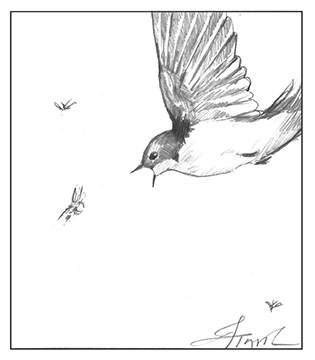When I worked at a barn one summer during college, I marveled at the swallows that nested in the structure’s eaves and corners. I watched the iridescent birds swoop, flutter, and dart with amazing dexterity between the small spaces above the stalls. These acrobatic birds are aerial insectivores, a group that also includes other swallows, swifts, nightjars, and the aptly named flycatchers. Many of New England’s avian summer residents eat insects, while most supplement their diets with other food sources. For aerial insectivores, insects are the primary item on the menu year-round — and they earn their dinner “on the wing.”
“There are a lot of insects up in the air space. We know that because birds are all the way up there feeding on them,” said Thomas Sherry, an avian ecologist and former professor at Tulane University who now lives in Vermont, where he’s writing a book on insectivores in the tropics. “Insects are moving around a lot for their own purposes, like mating and dispersal.”
Scientists refer to that patchy spread of insects throughout the ground-to-sky gradient as “aerial plankton.” Aerial insectivores must fly long distances to locate these groups of airborne insects, and then remain aloft to feed on them. Aerial insectivores are distinctly adapted — with pointed wingtips and a large wing size relative to their body — to help them reduce the amount of energy required to fly for such lengthy episodes.
“One of the most obvious adaptations for flight efficiency is pointed wingtips,” Sherry said, noting that, unlike the rounded wingtips of many forest birds, a pointed wingtip “creates less drag on the wing by allowing easier air movement around the tips.”
Aerial insectivores must also be able to maneuver deftly in air to catch their mobile quarry. This is where proportionally large wings come into play.
“The wheeling and turning is facilitated by a relatively large wing area for the size of the bird. It catches the air and allows them to turn quickly,” Sherry said. This phenomenon is called “low-wing loading,” and is perhaps best demonstrated by the foraging flights of the common nighthawk, a type of nightjar. Nighthawks are crepuscular, hunting at dawn and dusk, and must change direction constantly as they chase moths and other winged nocturnal insects. Sherry recalls watching groups of nighthawks migrating south along the Connecticut River before nightfall, following patches of flying ants and other invertebrates.
Beyond their unique wings, aerial insectivores benefit from additional adaptations that aid them in foraging. Richard Holmes, an emeritus professor and avian ecologist at Dartmouth College, explained that some aerial insectivores possess a ring of specialized feathers surrounding their beaks, called “rictal bristles,” which may serve to funnel prey into their mouths and protect their eyes in flight. Other studies propose that these feathers help birds orient themselves in air. Flycatchers, meanwhile, have enhanced vision that allows them to track their miniscule targets. A 2016 study by researchers at Uppsala University in Sweden found that some flycatcher species’ ability to detect and follow movement is up to 25% better than that of other birds. Compared to many of their avian brethren, flycatchers effectively view the world (and their tiny, zipping meals) in slow motion.
Despite these adaptations, populations of many aerial insectivore species have decreased over the past half-century. These declines are largely due to habitat loss, pesticide use, and a growing disparity in timing between when aerial insectivores’ prey hatches and when these birds migrate and arrive at their breeding grounds — a result of the changing climate.
Ornithologists point to the downward trend in insect populations as perhaps the key culprit in the decline of these birds. According to the North American Breeding Bird Survey, common nighthawk and eastern whippoorwill declines are particularly steep, which the Cornell Lab of Ornithology attributes to “the loss of open-understory forests” and pesticide-induced reductions in numbers of mosquitos and other nocturnal insects, among other factors. The populations of some swallows and flycatchers, meanwhile, appear to be stable or declining less precipitously.
We can support aerial insectivores by avoiding pesticide use, converting lawns to meadows, and gardening with native plants to bolster insect abundance. I hope to continue to see chimney swifts and swallows winding sinuous paths through the late-afternoon sky — on the wing and on the hunt for their next meal.
Colby Galliher is a writer who calls the woods, meadows, and rivers of New England home. To learn more about his work, visit colbygalliher.com. Illustration by Adelaide Murphy Tyrol. The Outside Story is assigned and edited by Northern Woodlands magazine and sponsored by the Wellborn Ecology Fund of the New Hampshire Charitable Foundation: nhcf.org.




